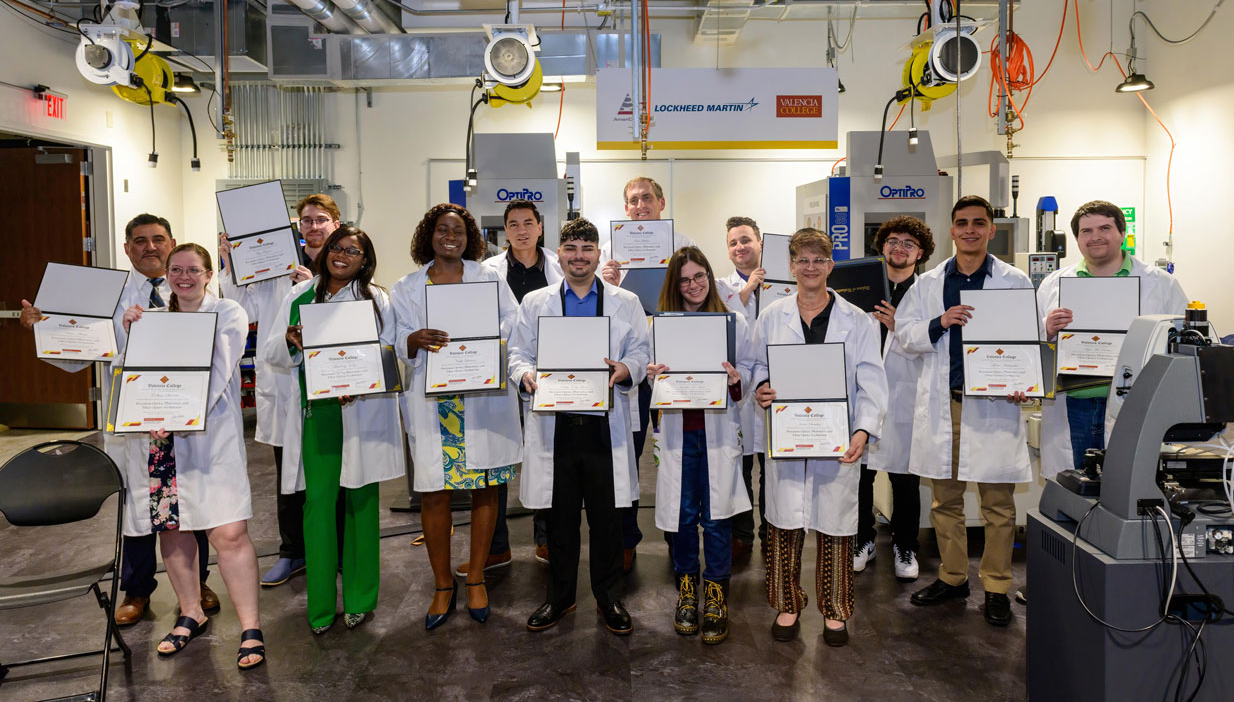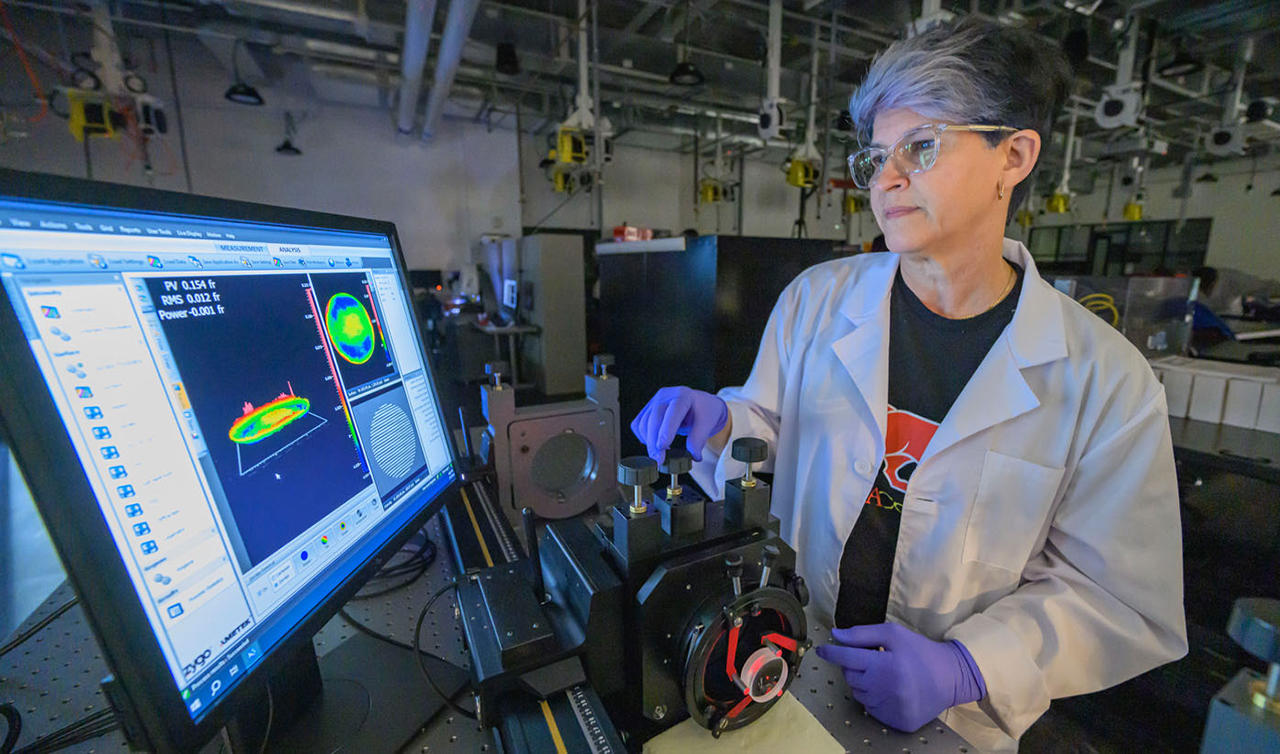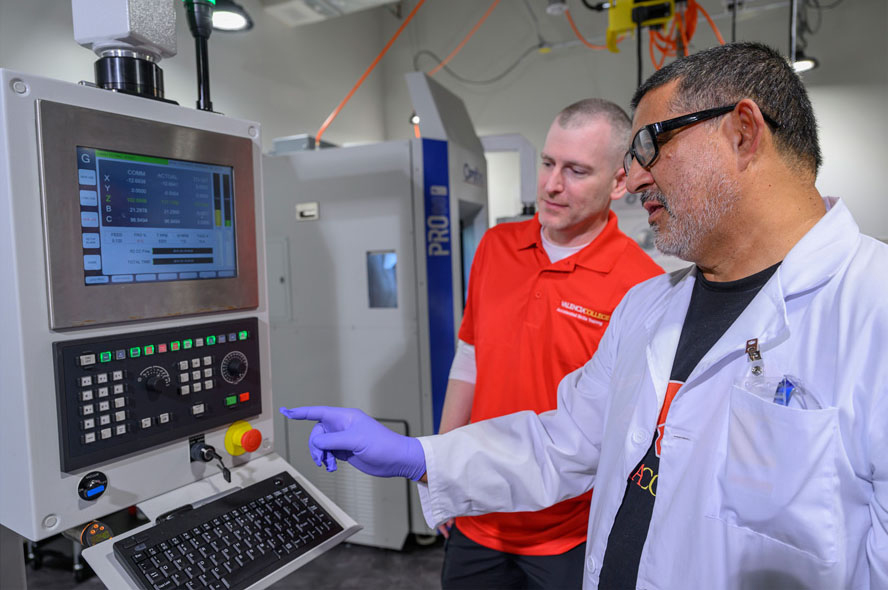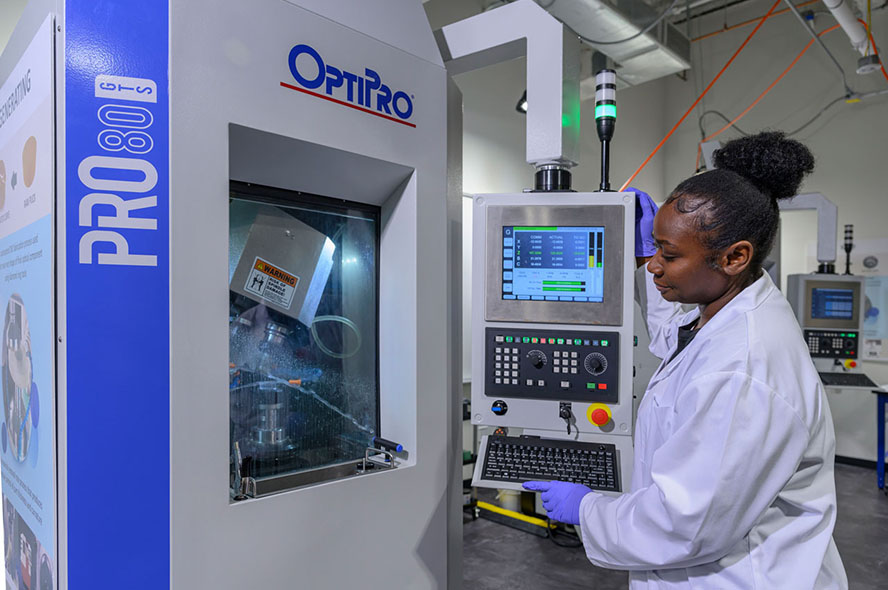
Two years in, a pioneering program is producing skilled technicians and bright futures in Central Florida.
“Many community college students take three or four years to finish a degree because they’re working full time,” says Carolyn McMorran, Assistant Vice President for Professional Continuing Education at Valencia.
“Our program is different. In just 15 weeks, students can train at night, complete the program, and move into a family-sustaining career.”


Valencia College – AST program’s first graduating class in the Optics, Photonics & Fiber Optics Technology class.
The short course advantage
Valencia’s program runs three cohorts a year, each with 12 students. It is designed around intensive, hands-on learning in small groups that quickly build confidence and skills.
“I tell students, you can do anything for 15 weeks, and they know those 15 weeks are going to change their lives,” McMorran says.
The approach is working: the program boasts a 96% completion rate, far above the community college norm. Students earn nationally recognized credentials—including OSHA 10 and the Technician in Precision Optics certification—and graduate into careers with an average starting wage of $20.71 per hour, well above Florida’s minimum wage.
“The short-term model gives people an edge,” McMorran says. “When they walk into a job interview, they can show they have the exact skills employers are looking for.”

Valencia College – AST program’s first graduating class in the Optics, Photonics & Fiber Optics Technology class.
Who’s in the classroom
The optics cohorts reflect the diversity of Central Florida’s workforce. The median age is 29, but students range from recent high school graduates to mid-career adults looking to restart.
“One of our earliest students had been working as a security guard for ten years, earning $13 an hour,” McMorran says. “After completing the program, she became an optics technician making $22 an hour. That’s life-changing.”
“We want people to know they have options beyond low wage jobs,” McMorran says. “Working in a lab is very different from working in an office or other business environments, and once people see the program, they get excited.”

Program students range from those who are coming right out of high school, to those starting a second career.
Building interest through impressive tours
Raising awareness has been one of the program’s biggest hurdles.
“Most people don’t know optics is even a career field until they tour our lab,” McMorran says.
That’s why Valencia relies heavily on grassroots outreach. Weekly tours bring prospective students into the state-of-the-art optics lab, where they see the technology firsthand. Personal connections play an equally important role.
“I often say the people currently doing the job are the best recruiters,” McMorran says.
Lockheed Martin, a major hiring partner, even published an internal newsletter about the program, generating referrals from employees. Friends and family referrals remain another powerful pipeline.
“People might think, ‘I want to be a welder,’ until they come in and discover we also have semiconductor robotics or optics,” McMorran says.
“We help people understand their options and find the right fit.”
Accelerated Skills Training: Part of a bigger model
Valencia’s optics program is one piece of a much larger effort known as Accelerated Skills Training (AST). These short, high-intensity programs prepare students for careers in industries ranging from advanced manufacturing to construction, healthcare, and transportation.
Unlike traditional two-year degrees, AST programs are designed to be career-ready in weeks, not years. Tuition costs are lower, schedules are flexible, and coursework is heavily hands-on. Many students graduate with stackable credentials and the ability to apply earned credits toward an associate’s degree if they wish to continue their education.
“AST is about speed, access, and alignment with industry,” McMorran says. “Our employers sit at the table with us to design programs, so when students graduate, they’re already trained in the equipment and processes they’ll see on the job.”
Entry-level wages across AST programs average $18–$27 per hour, and Valencia tracks strong outcomes in completion and job placement across the portfolio.

Students have hands-on training to better prepare for future employment.

Students learn on optics fabrication equipment that is current to what employers use in their facilities.
Inside the optics/photonics program
Within this broader AST ecosystem, the Optics/Photonics/Fiber Optics Technician Program has emerged as a standout. It runs for 15 weeks (300 clock hours), offered in the evenings from Monday to Thursday, with optional Friday skills labs. The program is based at Valencia’s Osceola Campus.
The cost is $7,000, and graduates typically earn $20–$23 an hour in entry-level optics roles. Students exit with nationally recognized certifications:
- Technician in Precision Optics (TPO) – ETA International
- Industrial Laser Safety Officer (LSO) certification
- OSHA 10 (General Industry)
Career pathways include precision optics technician, optics fabrication and assembly, photonics technician, metrology technician, and optical operator. The program also articulates into the Electrical and Computer Engineering Technology A.S. degree, giving graduates a pathway toward advanced study.
McMorran says the short-term model helps students see the finish line.
“I tell them, you can do anything for 15 weeks, and it will change your life,” she says. “That message resonates with people who don’t see themselves in a four-year degree program but know they need new skills to move ahead.”
“Most people don’t know optics is even a career field until they tour our lab. Once they see it, they get excited.”
Partnership power
The program would not exist without external support. AmeriCOM and the Department of War provide more than $1.1 million in funding for equipment and lab setup, accelerating the launch by years. Several optics companies—including Lockheed Martin, LightPath, Ocean Optics, ER Precision, and Jenoptik—work closely with the college, providing guidance on curriculum and opening doors to careers.
“It really felt like having a big brother or sister,” McMorran says. “AmeriCOM moved the lever to get us up and running so quickly. And employers like Lockheed ensure our students graduate with the skills the industry actually needs.”
The formal partnership between Valencia and AmeriCOM, established in 2021, continues to shape the program’s direction—aligning local workforce training with national priorities in advanced manufacturing and photonics. “We would not have a program were it not for AmeriCOM,” McMorran says.
Looking ahead
Now entering its fifth cohort, Valencia plans to continue expanding the program, adding high school dual-enrollment options and specialized training for incumbent workers. For students and employers alike, the future is bright.
“As we grow, the AmeriCOM–Valencia partnership remains central to our momentum,” McMorran says. “We want employers to come to us when they need talent, and our goal is to give students careers that truly change their lives.”